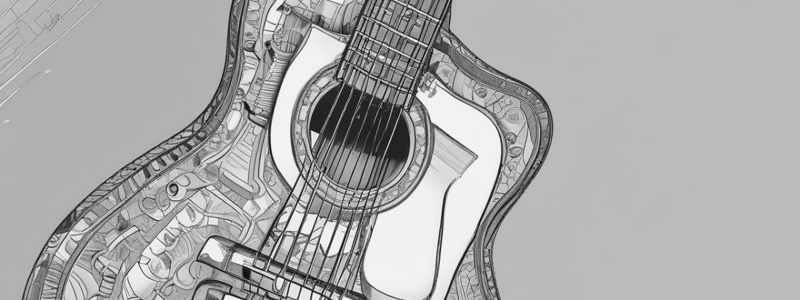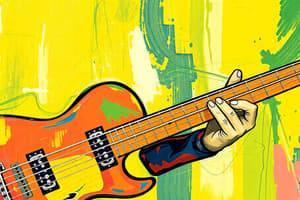Podcast
Questions and Answers
What allows the sound to escape and resonate in acoustic guitars?
What allows the sound to escape and resonate in acoustic guitars?
- Pickups
- Soundhole (correct)
- String vibrations
- Body shape
What is the primary function of pickups in electric guitars?
What is the primary function of pickups in electric guitars?
- To amplify the sound
- To produce sound waves
- To convert string vibrations into electrical signals (correct)
- To change the tone of the guitar
What is the benefit of understanding the anatomy of a guitar for musicians?
What is the benefit of understanding the anatomy of a guitar for musicians?
- To customize their instrument
- To play louder
- To develop a deeper knowledge of their instrument and make informed choices (correct)
- To improve their playing techniques
What is the main difference between acoustic and electric guitars in terms of sound production?
What is the main difference between acoustic and electric guitars in terms of sound production?
What is the purpose of an amplifier in electric guitars?
What is the purpose of an amplifier in electric guitars?
What is affected by the size and placement of the soundhole in acoustic guitars?
What is affected by the size and placement of the soundhole in acoustic guitars?
What is the main function of the headstock on a guitar?
What is the main function of the headstock on a guitar?
What is the purpose of the tuning pegs on a guitar?
What is the purpose of the tuning pegs on a guitar?
What is the name of the flat surface attached to the neck of a guitar?
What is the name of the flat surface attached to the neck of a guitar?
What determines the pitch of the notes produced on a guitar?
What determines the pitch of the notes produced on a guitar?
Where are the inlays or position marks typically found on a guitar?
Where are the inlays or position marks typically found on a guitar?
What is the main function of the body of a guitar?
What is the main function of the body of a guitar?
What is the material typically used to craft the neck of a guitar?
What is the material typically used to craft the neck of a guitar?
What is the purpose of the neck on a guitar?
What is the purpose of the neck on a guitar?
Flashcards are hidden until you start studying
Study Notes
The Headstock
- Located at the end of the neck, plays a vital role in maintaining string tension and tuning
- Holds the tuning pegs, used to adjust string tension and achieve desired pitch
- Design can vary, often showcases the brand logo or name of the guitar
The Neck
- Long, slender part of the guitar that connects the headstock and the body
- Typically crafted from wood, varies in length, width, and shape
- Houses the fretboard, where the player presses the strings to produce different notes
The Tuning Pegs
- Also known as machine heads, located on the headstock
- Allow adjustment of string tension individually, raising or lowering pitch
- Proper tuning is essential for producing pleasing and accurate sounds
The Fretboard
- Flat surface attached to the neck, usually made of wood
- Divided into sections called frets, determining pitch of notes produced when strings are pressed
- Typically features inlays or position marks on the 3rd, 5th, 7th, 9th, and 12th frets
The Body
- Main resonating chamber that amplifies sound produced by strings
- Comes in various shapes and sizes, such as dreadnought, concert, or electric guitar bodies
- Construction and materials greatly influence tonal qualities and overall sound projection
The Soundhole (Acoustic Guitars)
- Circular opening in the body of acoustic guitars, allows sound to escape and resonate
- Size and placement of the soundhole contribute to the guitar's unique sound and projection
The Pickups (Electric Guitars)
- Electromagnetic devices located beneath the strings, convert string vibrations into electrical signals
- Signals sent to an amplifier, producing a louder sound
- Type and configuration of pickups greatly impact the electric guitar's tonal palette and versatility
Studying That Suits You
Use AI to generate personalized quizzes and flashcards to suit your learning preferences.




